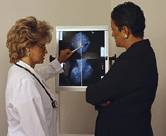- Navigating Your Midlife Crisis: Embracing New Possibilities
- City Raccoons Showing Signs of Domestication
- Mapping the Exposome: Science Broadens Focus to Environmental Disease Triggers
- One Week Less on Social Media Linked to Better Mental Health
- Your Brain Changes in Stages as You Age, Study Finds
- Some Suicide Victims Show No Typical Warning Signs, Study Finds
- ByHeart Formula Faces Lawsuits After Babies Sickened With Botulism
- Switch to Vegan Diet Could Cut Your Greenhouse Gas Emissions in Half
- Regular Bedtime Does Wonders for Blood Pressure
- Dining Alone Could Mean Worse Nutrition for Seniors
Double Mastectomy Often Not Needed, Study Finds


Many breast cancer patients who have their second breast removed as a precaution don’t actually need the double mastectomy, a new study finds.
Researchers who evaluated more than 1,400 women with breast cancer found that nearly 7 out of 10 who underwent preventive removal of their healthy breast were not at high risk of cancer in the unaffected breast.
“What we found is that almost 70 percent did not have a clinical indication for it,” said study researcher Sarah Hawley, an associate professor of internal medicine at the University of Michigan, Ann Arbor. The researchers defined a clinical indication as having the genetic mutation BRCA 1 or 2 or a strong family history of breast cancer, both of which raise breast cancer risk.
The dual procedure — known as contralateral prophylactic mastectomy — has increased markedly in recent years, even though experts suggest it only be considered in these high-risk cases.
Hawley and others believe fear of developing cancer in the healthy breast drives these decisions, and they suspect the fear is often out of proportion to the actual risk. The new study, published online May 21 in JAMA Surgery, suggests that is true.
Hawley’s team evaluated 1,447 women who had been treated for breast cancer but had not had a recurrence. The women reported information to breast cancer registries from 2005 to 2007 and again from 2009 to 2010.
Nearly 19 percent said they strongly considered having the opposite unaffected breast removed, and about 8 percent actually had the procedure.
However, about 69 percent of those who had the double mastectomy had no major genetic or family risk factors for getting cancer in the other breast, Hawley found.
Those who chose the preventive mastectomy were more likely than others to express worry about cancer affecting the opposite breast.
Certain factors, including having an MRI test and higher education, also made the decision to remove the healthy breast more likely, Hawley found. MRIs often reveal areas that look suspicious, but turn out to be nothing. Even so, that can trigger worry, Hawley said.
The author of an editorial accompanying the study said some fear is healthy. “It’s a reasonable thing to be fearful of recurrence,” said Dr. Ann Partridge, a breast oncologist and director of the adult survivorship program at Dana-Farber Cancer Institute in Boston.
“What you hope is that fear motivates them to comply with treatment,” she said. “What you hope the fear doesn’t do is cripple them.”
She advises women to put the risk in perspective, which is not always easy. “The average risk of a new primary cancer in the opposite breast is about 2.5 percent over five years,” she said. That risk can be halved with use of hormonal drugs, she added.
For women with risky genetic mutations, the likelihood of a new primary cancer in the opposite breast is 20 percent over the next five years, she said.
Making the decision is difficult, regardless of risk, Partridge said. “It’s so stressful,” she said. “There are many women who are making this decision in the throes of a diagnosis.”
Talk over the risks and benefits with your doctors, she advises. If you’re still unsure, she recommends taking the process step by step.
“Let the dust settle,” she said. “Get the breast treated you need to get treated. You can always go back.”
Health care professionals should take their patients’ fears into account, Partridge believes. “We need to be aware of that anxiety, help women deal with it,” she said. Treatment decisions should be driven by shared decision-making between a woman and her doctors, not by anxiety, she added.
More information
To learn more about breast cancer, visit American Cancer Society.
Source: HealthDay
Copyright © 2025 HealthDay. All rights reserved.










